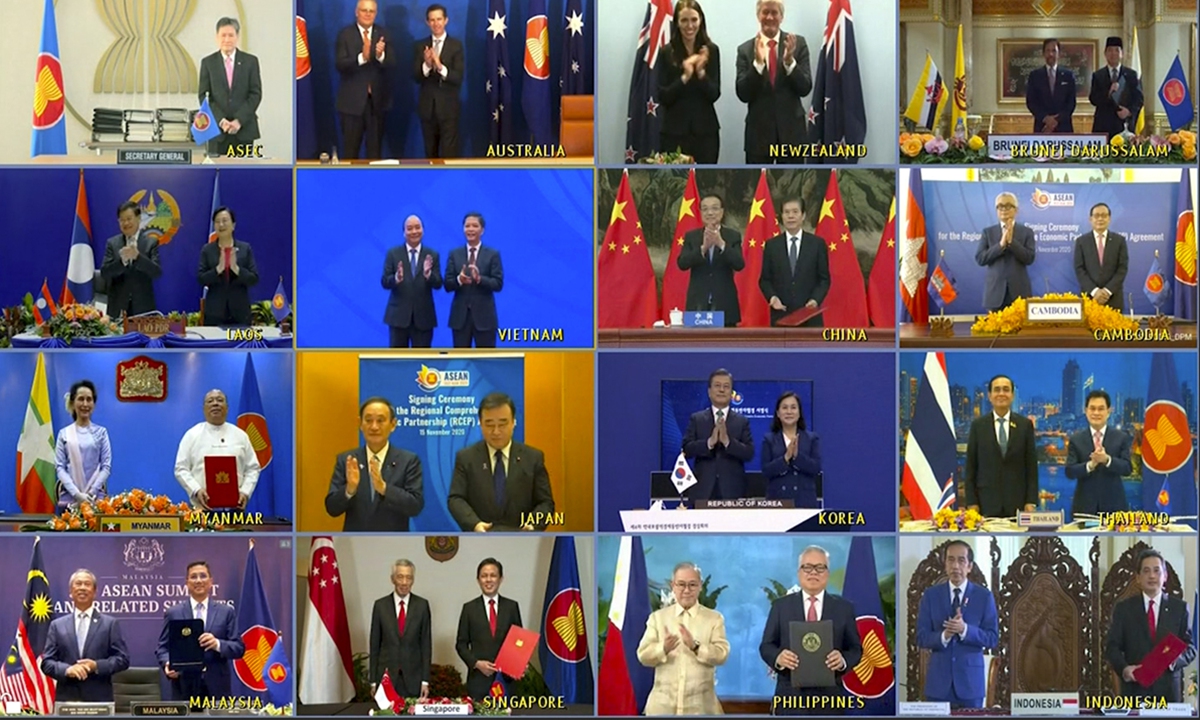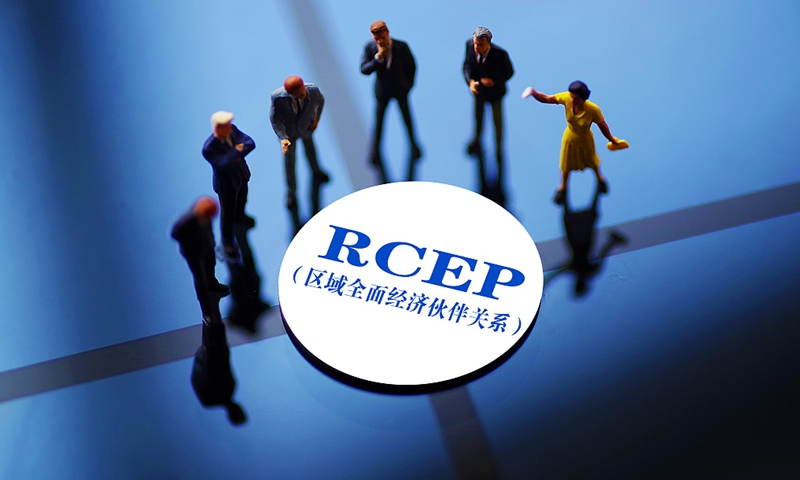Asia markets rally on RCEP, bullish on future
By Wang Cong Source: Global Times Published: 2020/11/16 19:08:40 Last Updated: 2020/11/16 20:08:40
Megadeal also faces challenges, meddling from US: expert

This image made from a teleconference provided by the Vietnam News Agency (VNA) shows the leaders and trade ministers of 15 Regional Comprehensive Economic Partnership (RCEP) countries pose for a virtual group photo in Hanoi, Vietnam on Sunday. Photo: AP
Asia-Pacific financial markets rallied on Monday as investors issued a vote of confidence to the signing of the world's largest trade agreement, the Regional Comprehensive Economic Partnership (RCEP), reflecting the markets' upbeat sentiment toward the long-term economic benefits of the deal, even as hurdles and challenges remain in its implementation.
While officials from the 15 member countries continue to celebrate what they call a historic win for free trade and multilateralism, tasks and challenges need to be addressed, including lingering political and trade disputes between member states and meddling from the US, for the trade partners to fully carry out the deal and unleash its full potential, Chinese experts said.
Upbeat sentiment
Following the signing of the RCEP on Sunday, stock markets across the Asia-Pacific rallied on Monday. In China, the benchmark Shanghai Composite Index gained 1.11 percent at market close. In Japan, the Nikkei 225 rose 2.05 percent. In South Korea, the Kospi also gained nearly 2 percent. In Australia, the S&P/ASX 200 rose 1.23 percent.
"The market rally shows that investors are very positive about the potential of the RCEP," Yang Delong, chief economist at Shenzhen-based First Seafront Fund Management, told the Global Times on Monday, adding that the deal would boost many export-oriented sectors, and overall economic growth.
Consisting of China, Japan, South Korea, Australia, New Zealand and 10 Southeast Asian countries, the RCEP is the world's largest trade agreement, with a combined population of 2.27 billion, $26 trillion in GDP, and $5.2 trillion in exports. The 14,000-page agreement, which contains 20 chapters, not only touches on lowering tariffs on trade among member countries but also includes measures to remove barriers for investment, as well as travel.
"Overall, the RCEP is a modern, comprehensive, high-quality and win-win major free trade agreement," the Chinese Ministry of Commerce (MOFCOM) said in a statement on Monday, adding that the signing of the deal marks the start of the world's "largest" free trade zone with the "biggest potential."
The agreement could boost exports among member countries by 10.4 percent by 2025, investments by 2.6 percent, and GDP by 1.8 percent, MOFCOM said. For China, the deal could lift its GDP by 0.5 percent through 2030, Bloomberg reported. South Korea and Japan could also see a GDP boost of about 1.3 percent, the report said.
Among the main breakthroughs in the agreement were removing tariffs on 90 percent of merchandise immediately after its implementation, and zero tariffs in 10 years. Under the deal, the parties will also adopt a "negative list" for investments in manufacturing, agriculture and several other sectors. In a bid to boost regional integration, the agreement also includes arrangements for visas and money transfers.
Compared to other trade agreements, including the Comprehensive and Progressive Agreement for Trans-Pacific Partnership, the RCEP mostly focuses on trade liberalization rather than higher requirements for industrial and economic development, because the trade pact covers many developing countries, according to Cheng Yu, senior analyst at Kandong Institute.
"The RCEP's realistic nature is bigger than forward-looking," Cheng told the Global Times, adding that countries at different development stages have different pursuits in a trade deal, and the RCEP is the best at the moment for its diverse group of members. "The biggest value of the RCEP is trade liberalization for its members."

RCEP Photo: VCG
Beyond economic benefits, the RCEP could also become a valuable platform for member countries to pursue more bilateral trade deals and resolve trade and other disputes, officials and experts said.
As part of the RCEP, China also established a new free trade partnership with Japan. Japan and South Korea, which have been engaged in a trade dispute, also formed a new free trade partnership, MOFCOM said. There have also been reports of China, Japan and South Korea accelerating negotiations for their trilateral free trade agreement.
"The RCEP is an integrator of regional economic and trade rules," the MOFCOM said.
US meddling
However, the implementation of the agreement, which still requires certification from the member countries, will also face challenges and risks not only from internal disputes but also from US meddling, experts noted.
The Asia-Pacific has great potential for economic development, and the RCEP came in a timely fashion to help realize that potential. However, the region is also very diverse in economic and political systems, and there are many areas of dispute, experts said.
To fully implement the RCEP and unleash its massive potential, member countries should not allow internal disputes and US meddling to disrupt the process, Chinese experts noted.
While the member countries are close economic and trade partners, there remain political disputes between some of them, including trade disputes between Japan and South Korea, and diplomatic tensions between China and Australia over the latter's role in helping the US attack on China. Externally, as part of its ill-attempt to contain China, the US has been stirring up tensions in the region.
"The US' economic influence in the Asia-Pacific region has shrunk significantly. To increase confrontation, it will try to rope in some member countries and divide the 15 members at the same time," Zhang Xiaorong, director of the Beijing-based Cutting-Edge Technology Research Institute, told the Global Times.
The US has long been pursuing an Ill-intended attempt to contain China's rise. Even before Donald Trump assumed office, the US initiated negotiations for the TPP, which was widely viewed as a strategy to isolate China. Although the Trump administration withdrew from the TPP, it has continued that approach by stirring up tensions in the South China Sea.
As Joe Biden, who was part of the US administration that pushed for TPP, is set to take over the US presidency, analysts warned that the US might try to disrupt the RCEP.
"The RCEP has basically cut out the US... it now could join the CPTPP and compete with the RCEP," Hu Qimu, a senior fellow at the Sinosteel Economic Research Institute, told the Global Times.
However, while the US might pose some obstacles, it would not be able to disrupt the process, given the benefits of the RCEP for the member countries, experts said. For many countries, the RCEP is a better option than a strict demand proposed by the US.
"The US-led multilateral trade mechanism in the Asia-Pacific has very high requirement in areas such as services, and does not fit many in the region," Hu said, adding the RCEP is based on each country's existing industrial advantage, and is more attractive to ASEAN countries.